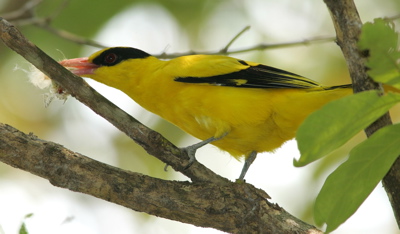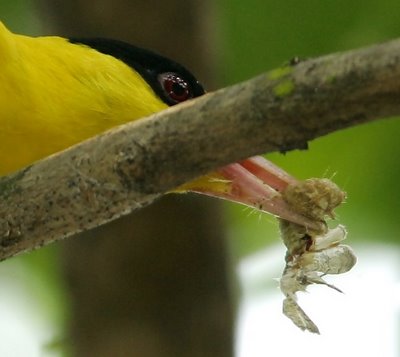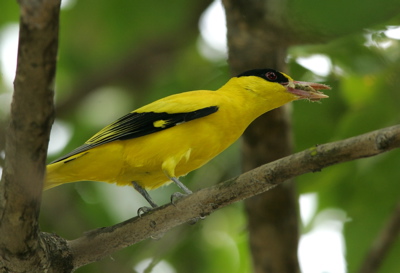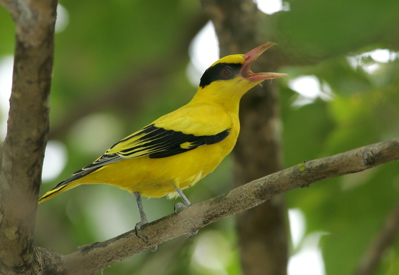Black-naped Oriole manipulating a cocoon
 In October 2006 Meng and Melinda Chan chanced upon a Black-naped Oriole (Oriolus chinensis) snatching a whitish cocoon from the branch of a tree (above). The thick, tough silken covering that made up the cocoon was a challenge to the bird (below).
In October 2006 Meng and Melinda Chan chanced upon a Black-naped Oriole (Oriolus chinensis) snatching a whitish cocoon from the branch of a tree (above). The thick, tough silken covering that made up the cocoon was a challenge to the bird (below).  Gripping the cocoon in its bill, the bird furiously rubbed it against a branch in an effort to remove the silk covering (below).
Gripping the cocoon in its bill, the bird furiously rubbed it against a branch in an effort to remove the silk covering (below). 
 In less than three minutes it succeeded in removing most of the cocoon silk to get at the succulent pupa inside (bleow).
In less than three minutes it succeeded in removing most of the cocoon silk to get at the succulent pupa inside (bleow).  In a flash it swallowed the defenceless pupa. Satisfied with its meal, the bird gave a short call (below).
In a flash it swallowed the defenceless pupa. Satisfied with its meal, the bird gave a short call (below). 
 Many moths and a few butterflies weave a cocoon of silk, inside which the caterpillar pupates. These cocoons are thick and tough or they can consist of a few strands of silk that keep the pupa from falling, or hold materials together to form a shelter.
Many moths and a few butterflies weave a cocoon of silk, inside which the caterpillar pupates. These cocoons are thick and tough or they can consist of a few strands of silk that keep the pupa from falling, or hold materials together to form a shelter. Cocoons may be formed from substrate materials held together by silk. Some are so tough that they need a special escape lid woven to the end for the emergence of the adult, like the silkworm.
 The cocoon of the Atlas Moth (Attacus atlas) (above) is a good example of how tough the silken cover is. The image below shows the longi-section of the cocoon with the remains of the pupa after the moth had emerged.
The cocoon of the Atlas Moth (Attacus atlas) (above) is a good example of how tough the silken cover is. The image below shows the longi-section of the cocoon with the remains of the pupa after the moth had emerged.  Khew Sin Khoon, who operates the website Butterflies of Singapore (http://www.geocities.com/RainForest/Vines/2382/index.html), agrees that the cocoon is most probably that of a lepidoptera. He believes that it is probably that of a moth rather than that of a butterfly. Why? Because there is too much silk and “the fuzzy stuff” to be that of a butterfly.
Khew Sin Khoon, who operates the website Butterflies of Singapore (http://www.geocities.com/RainForest/Vines/2382/index.html), agrees that the cocoon is most probably that of a lepidoptera. He believes that it is probably that of a moth rather than that of a butterfly. Why? Because there is too much silk and “the fuzzy stuff” to be that of a butterfly. Input by Melinda Chan, images of oriole by Chan Yoke Meng and those of the Atlas Moth cocoon by YC.
Labels: Feeding



0 Comments:
Post a Comment
<< Home